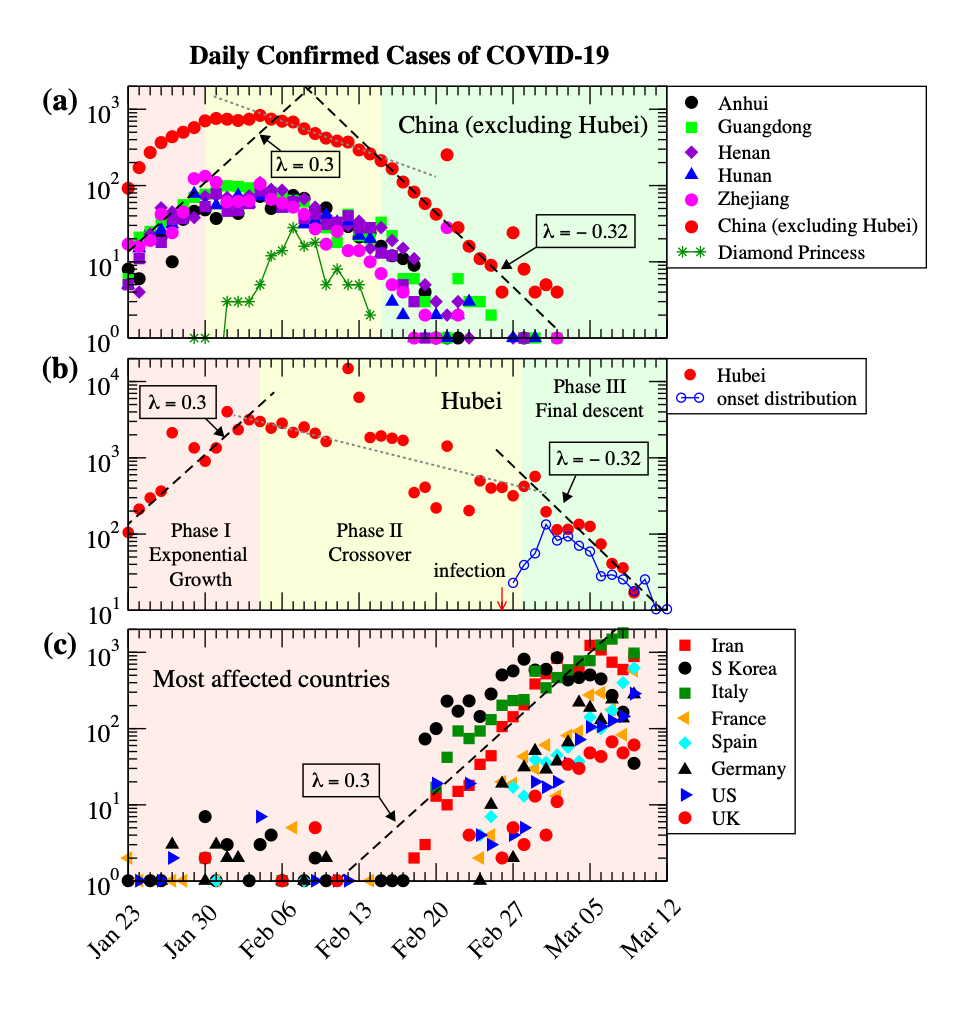Globally, one of the biggest challenges to determining the appropriate policy response to the 2019 Coronavirus Disease (COVID-19) has been the uncertainty of pre-symptomatic transmission and the lack of tools to quantify and predict its impact 1,2. Under certain conditions, pre-symptomatic and asymptomatic individuals may constitute a significant proportion of the overall infected population, 51% in the case of the Diamond Princess cruise ship based on data from February 20, 2020 3. A number of studies 4,5 suggested that this group of viral carriers could contribute significantly to the spread of the SARS-CoV-2 virus.
To address this challenge, a team of researchers led by Professor Leihan Tang from the Hong Kong Baptist University and the Beijing Computational Science Research Center developed a universal empirical model driven by pre-symptomatic transmission to explain similarities in epidemic developments across China since the Wuhan lockdown on January 23, 2020 (upper panel, accompanying figure, with data from the Johns Hopkins CSSE Repository 6). In the first week after the lockdown, the number of newly confirmed cases continued to grow at a universal rate of approximately 0.3 per day. This is followed by a crossover phase lasting 2 to 3 weeks under stringent tracking, isolation and quarantine measures. The final descent towards eradication of the spread of the virus again took a universal form of a tenfold reduction in the number of newly confirmed cases per week.
In Hubei province, where the outbreak originated, the crossover phase lasted for two more weeks due to a much more elevated scale of the epidemic that overwhelmed the local public health and disease control capabilities (middle panel, accompanying figure). Such behaviour is reproduced by the model when a reduced but finite communal transmission is assumed. However, starting from about March 3, 2020, the rate of decrease in the number of newly confirmed cases began to conform to and finally reached the value seen in the rest of the country. Mathematical analysis of the model identifies the decay with the tail of the clinically defined symptom onset time distribution. The statistics of the onset time, which has been extracted from previous case studies on SARS-CoV-2 infection 7,8, yields an upper bound on how fast the daily count approaches zero.
While the outbreak is subsiding in China, exponential growth with a daily rate of around 0.3 is seen in the latest epidemic data from a number of countries around the world 6 (bottom panel, accompanying figure). In the past few days, data for the newly confirmed cases in Iran and South Korea have started to exhibit the type of turn-around seen in China in February. The universal transmission model will help researchers and policy-makers monitor epidemic developments more efficiently and to assess whether the isolation and social-distancing policies in place are sufficient, or if further measures are needed, against economic implications and social sacrifice on a grand scale.
Accompanying Figure

Sources:
1. WHO situation report-50 (March 10, 2020): https://www.who.int/docs/default-source/coronaviruse/situation-reports/20200310-sitrep-50-covid-19.pdf?sfvrsn=55e904fb_2
2. https://www.thelancet.com/journals/lancet/article/PIIS0140-6736(20)30567-5/fulltext [Anderson, Roy M., Hans Heesterbeek, Don Klinkenberg, and T. Déirdre Hollingsworth. "How will country-based mitigation measures influence the course of the COVID-19 epidemic?" The Lancet (2020).]
3. Diamond Princess field report as of February 20, 2020 https://www.niid.go.jp/niid/en/2019-ncov-e/9417-covid-dp-fe-02.html
4. https://www.thelancet.com/journals/laninf/article/PIIS1473-3099(20)30147-X/fulltext [Huang, Rui, Juan Xia, Yuxin Chen, Chun Shan, and Chao Wu. "A family cluster of SARS-CoV-2 infection involving 11 patients in Nanjing, China." The Lancet Infectious Diseases (2020).]
5. https://link.springer.com/article/10.1007/s11427-020-1661-4 [Hu, Zhiliang, Ci Song, Chuanjun Xu, Guangfu Jin, Yaling Chen, Xin Xu, Hongxia Ma et al. "Clinical characteristics of 24 asymptomatic infections with COVID-19 screened among close contacts in Nanjing, China." Science China Life Sciences (2020): 1-6.]
6. https://www.thelancet.com/journals/laninf/article/PIIS1473-3099(20)30120-1/fulltext [Dong, Ensheng, Hongru Du, and Lauren Gardner. "An interactive web-based dashboard to track COVID-19 in real time." The Lancet Infectious Diseases (2020).]
7. https://www.medrxiv.org/content/10.1101/2020.02.19.20025031v1 [Lu, Hongzhou, Jingwen Ai, Yinzhong Shen, Yang Li, Tao Li, Xian Zhou, Haocheng Zhang et al. "A descriptive study of the impact of diseases control and prevention on the epidemics dynamics and clinical features of SARS-CoV-2 outbreak in Shanghai, lessons learned for metropolis epidemics prevention." medRxiv (2020).]
8. https://www.medrxiv.org/content/10.1101/2020.02.24.20027474v1 [Han, Henry. "Estimate the incubation period of coronavirus 2019 (COVID-19)." medRxiv (2020).]



